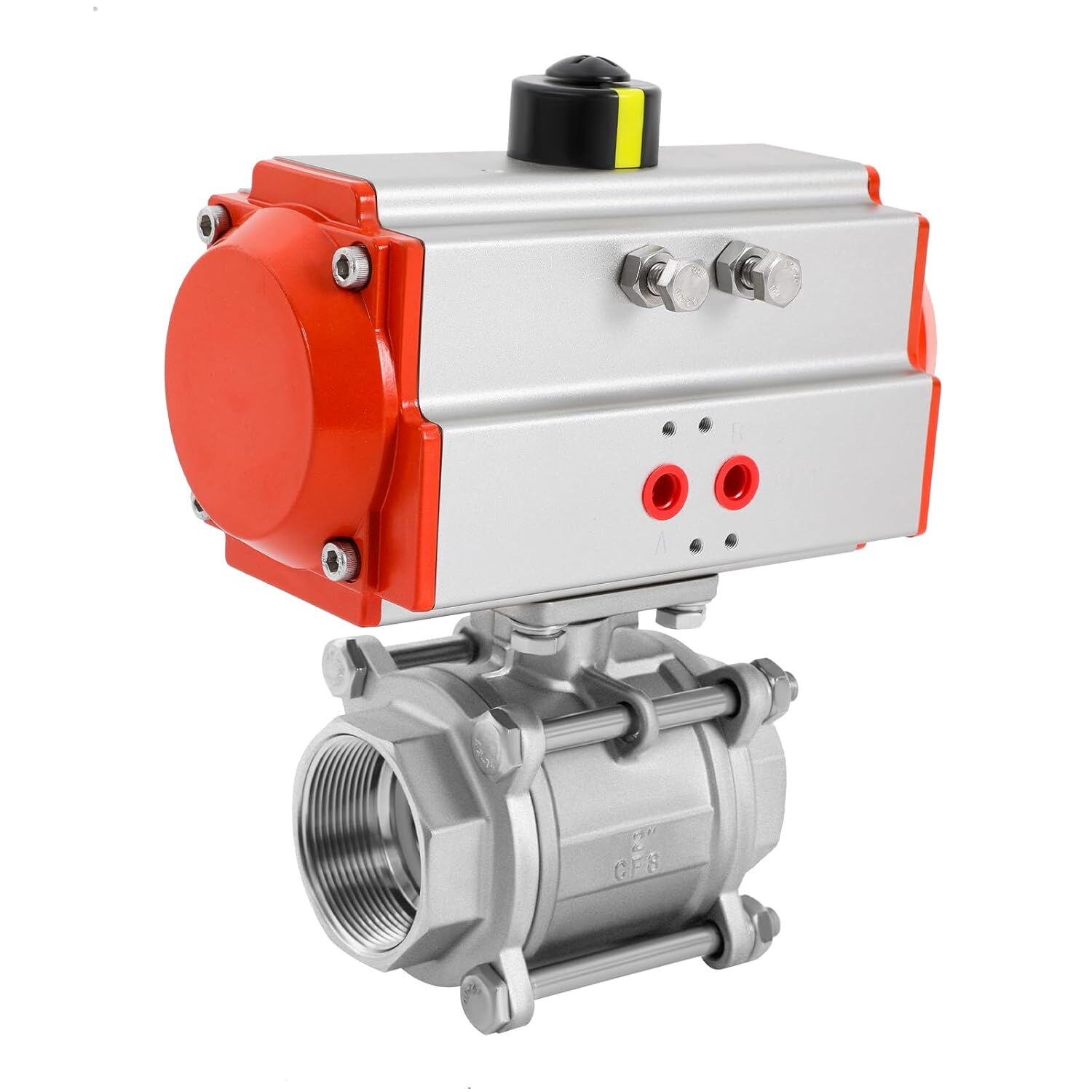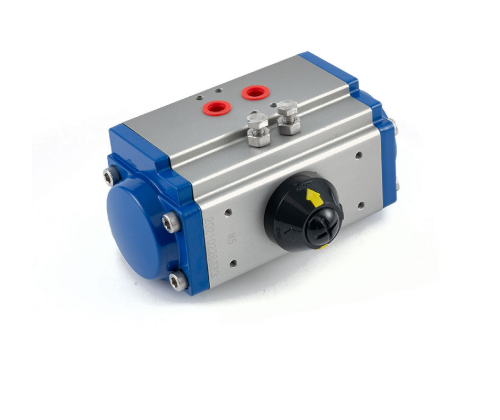
In today’s fast-paced industrial environment, automation is no longer a luxury—it is a necessity. From manufacturing plants to food processing facilities, automated systems drive efficiency, consistency, and safety. At the heart of many of these systems lies a key component that converts compressed air into mechanical motion: the pneumatic actuator.
Pneumatic actuators are mechanical devices designed to open, close, or modulate valves, dampers, or other machinery automatically. By converting air pressure into motion, these actuators streamline processes that would otherwise require manual intervention, improving productivity while reducing the risk of human error. Whether in a high-speed packaging line or a complex chemical processing plant, pneumatic actuators play an essential role in modern industrial automation.
This article explores the types, working principles, benefits, selection criteria, and applications of pneumatic actuators, providing a comprehensive guide for engineers, operators, and decision-makers.
A pneumatic actuator is a mechanical device that uses compressed air to produce motion. This motion can be linear (straight-line) or rotary (turning), depending on the design of the actuator. Pneumatic actuators are often used to control valves, dampers, or other mechanical devices, allowing for precise, automated operation without manual effort.
In essence, a pneumatic actuator functions as the automation equivalent of a muscle. Compressed air acts as a power source, creating motion that can be harnessed to move, rotate, or control a device. Unlike electric or hydraulic actuators, pneumatic systems rely solely on air, making them ideal for clean environments and applications where oil or hydraulic fluid could pose a contamination risk.

Pneumatic actuators come in multiple forms, classified primarily by the type of motion they generate: linear or rotary. Each type has unique advantages, and selecting the correct one depends on the specific operational requirements.
Linear actuators produce motion along a straight line. This is typically achieved by using a piston or diaphragm inside a cylinder. Compressed air enters the cylinder, exerting force on the piston, which then moves a rod to perform mechanical work.
Key Features of Linear Actuators:
Single-acting: Uses a return spring (or gravity) to return the piston to its initial position after the air pressure is released. This setup is energy-efficient because it requires air pressure only for the work stroke.
Double-acting: Air pressure is applied alternately on both sides of the piston to extend and retract it. This design allows for bidirectional control and precise positioning.
Linear actuators are commonly used for applications such as valve operation in pipelines, material handling, and robotic lifting mechanisms. Their straightforward design ensures reliability and minimal maintenance over long operational periods.
Rotary actuators, by contrast, generate rotational motion, often to operate a valve or a rotary component. They typically use rack-and-pinion mechanisms or vane assemblies to convert the linear motion of a piston into rotational motion.
Rack-and-Pinion Actuators: A piston moves in a cylinder, driving a gear rack attached to a pinion gear. The pinion rotates, providing precise control of the rotary output shaft.
Vane Actuators: A vane is mounted inside a cylinder and connected to a shaft. Compressed air enters chambers on either side of the vane, causing it to rotate and transmit motion to the shaft.
Rotary actuators are particularly effective for quarter-turn applications, such as ball valves or butterfly valves, where a 90-degree rotation is needed. They are compact, reliable, and capable of high-speed operation.
Understanding the working principles of pneumatic actuators is critical for selecting and maintaining the right device for an application.
Pneumatic actuators convert the energy stored in compressed air into mechanical motion. When air pressure enters the actuator chamber, it creates a force that moves an internal element, usually a piston or diaphragm. This motion can be either linear or rotary, depending on the actuator type.
Linear Motion: Compressed air pushes the piston within a cylinder, causing it to move along a straight path. In single-acting actuators, a spring returns the piston once air pressure is released. In double-acting actuators, air pressure alternates on either side of the piston, allowing bidirectional movement without relying on a spring.
Rotary Motion: Some actuators convert linear motion into rotation using rack-and-pinion setups or vane mechanisms. This type is ideal for turning valves or other rotary components, where precise angular movement is required.
The force generated by a pneumatic actuator depends on the surface area of the piston or diaphragm and the air pressure applied. Higher pressure or a larger piston area results in more force. Speed, on the other hand, is influenced by the airflow rate into and out of the actuator chamber, as well as the load being moved.
By adjusting air pressure, flow rate, or the actuator design itself, engineers can fine-tune performance to meet exact operational requirements.
Pneumatic actuators are widely favored in industrial automation because they combine simplicity, reliability, and efficiency. Here are some of the key advantages:
Simplicity: Pneumatic actuators have fewer moving parts than hydraulic or electric actuators, reducing complexity and the likelihood of mechanical failure.
Cost-Effectiveness: Compressed air is generally cheaper and easier to manage than hydraulic fluids or electrical systems, making pneumatic actuators an economical choice.
Reliability: Well-designed pneumatic systems can handle millions of cycles with minimal maintenance, offering long-term operational stability.
Clean Operation: Pneumatic systems do not require oil or other fluids that might contaminate sensitive environments, making them ideal for food processing, pharmaceuticals, and electronics manufacturing.
Speed: Pneumatic actuators respond quickly to changes in control signals, enabling high-speed operation and precise motion control.
Safety: Air-driven actuators eliminate the risks associated with high-voltage electric systems or pressurized hydraulic fluids, providing inherent safety in hazardous environments.
Selecting the appropriate pneumatic actuator involves evaluating several application-specific factors:
Force Requirements: Determine the amount of force needed to move the load or operate the valve. This depends on the air pressure available and the actuator’s surface area.
Stroke Length: Measure the distance the actuator must travel. Linear actuators require sufficient stroke length to fully open or close the valve or damper.
Speed Requirements: Identify how quickly the actuator needs to respond. High-speed applications may require larger air ports or specialized cylinder designs.
Mounting and Space Constraints: Consider the physical space available for installation and ensure compatibility with the actuator’s mounting options.
Environmental Conditions: Check for factors such as temperature, humidity, or exposure to corrosive materials, and select materials and seals that can withstand these conditions.
Control Needs: Determine whether single-acting or double-acting actuators are required, or if precise position control is necessary, which might require additional accessories such as positioners.
By carefully assessing these factors, engineers can ensure optimal actuator performance, longevity, and cost efficiency.
Pneumatic actuators are versatile devices used in a wide range of industries, thanks to their reliability, speed, and ease of use.
In manufacturing plants, pneumatic actuators control assembly lines, conveyors, and robotic systems. They are also used in process control applications, such as regulating valves in chemical, pharmaceutical, or oil and gas processes.
Their ability to perform rapid, repetitive motions with minimal maintenance makes them ideal for high-volume production environments. Furthermore, pneumatic systems are relatively easy to integrate with programmable logic controllers (PLCs) and other automation platforms.
Pneumatic actuators find applications in automotive production and operation. In manufacturing, they control robotic arms, assembly equipment, and paint spraying systems. In vehicle systems, they are used in braking mechanisms, suspension adjustments, and engine control components, particularly in commercial or heavy-duty vehicles.
Robotics relies heavily on precise, repeatable motion. Pneumatic actuators power robotic arms, grippers, end-effectors, and pick-and-place systems. Their fast response times and consistent force output allow robots to perform delicate or high-speed tasks efficiently.
In packaging lines, pneumatic actuators drive filling, capping, labeling, and sorting operations. Their clean operation is critical in food processing and pharmaceutical applications, where contamination must be avoided. The speed and reliability of pneumatic actuators support high-volume production without compromising hygiene standards.
Pneumatic actuators are also widely used in heating, ventilation, and air conditioning (HVAC) systems to operate dampers, louvers, and valves. Their simplicity and reliability make them ideal for maintaining consistent environmental conditions in commercial buildings and industrial facilities.
Valves controlling water flow, filtration systems, and wastewater treatment facilities often rely on pneumatic actuators. The fast response time and low maintenance requirements of pneumatic systems ensure smooth operation in critical public utility applications.
Although pneumatic actuators are generally low-maintenance, periodic checks are essential to ensure optimal performance:
Air Supply Quality: Ensure compressed air is clean, dry, and free from contaminants. Moisture or oil can damage internal components.
Seal Inspection: Regularly check seals and diaphragms for wear, as leaks can reduce performance.
Lubrication: Some actuators require light lubrication, depending on the design. Follow manufacturer recommendations.
Alignment Checks: Ensure that the actuator and connected equipment remain properly aligned to avoid uneven wear or mechanical stress.
Control System Calibration: Verify that positioners, sensors, or controllers are functioning correctly to maintain precise motion control.
Prompt maintenance extends the life of the actuator, minimizes downtime, and ensures consistent performance in automated systems.
Pneumatic actuators are a cornerstone of modern automation, providing efficient, reliable, and cost-effective solutions for countless industrial applications. From manufacturing to robotics, automotive systems to food processing, these actuators convert the power of compressed air into controlled mechanical motion, enabling faster, safer, and cleaner operations.
With their versatility, speed, and durability, pneumatic actuators remain a preferred choice for engineers and operators worldwide. By understanding the types, working principles, benefits, and applications of these devices, industries can harness the full potential of pneumatic technology, ensuring seamless automation and optimized performance in today’s highly competitive industrial landscape.
As automation demands grow and industrial processes become more sophisticated, pneumatic actuators will continue to play a vital role in powering the factories, robotics, and infrastructure of the future.